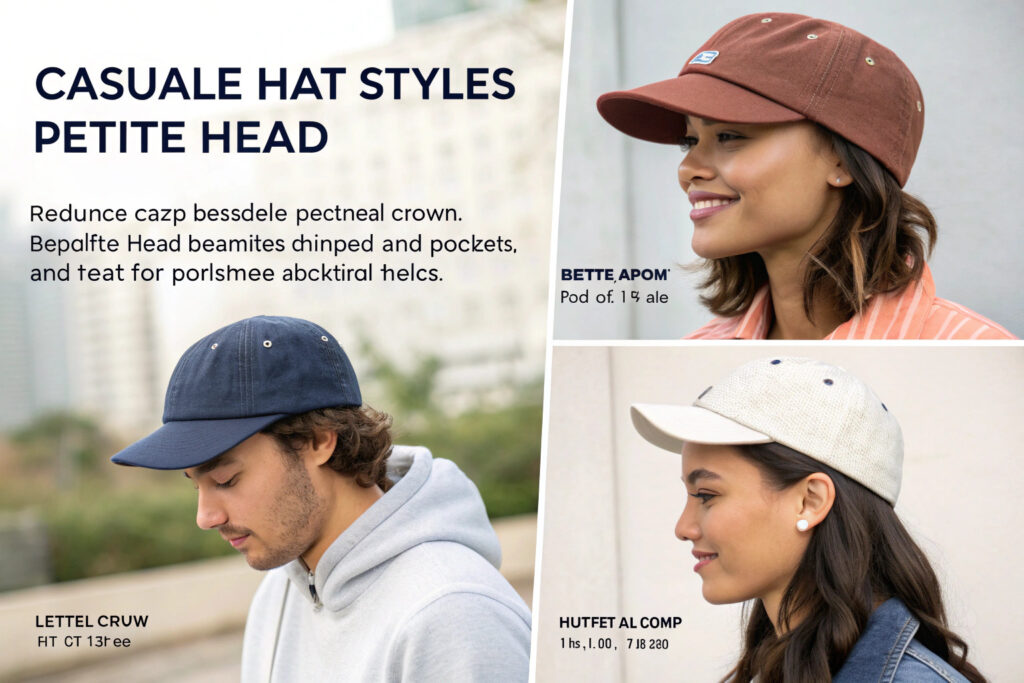Finding well-fitting hats for petite head sizes presents unique challenges that many standard hat designs fail to address. Petite individuals (typically those with head circumferences below 21 inches/53 cm) often struggle with hats that slide down over their eyes, feel disproportionately large, or lack the structural support needed to maintain their shape on smaller frames. This fit problem leads to frustration, limited wearing options, and missed sales opportunities for retailers.
The best hat styles for petite head sizes include structured baseball caps with adjustable closures, medium-brim fedoras, cloche-style designs, small-profile beanies, and custom-sized sun hats. These styles combine proportional scaling, secure fit systems, and appropriate structural elements that flatter smaller head sizes while providing comfortable, secure wear.
Understanding which design elements work for petite proportions helps both consumers find flattering options and manufacturers develop properly scaled products for this underserved market segment.
Why Do Standard Hat Designs Fail Petite Wearers?
Most mass-market hats are designed for average head sizes (22-23 inches/56-58 cm circumference), creating multiple fit issues for petite individuals. Understanding these specific challenges helps identify what makes certain styles work while others fail.
Standard hats typically fail petite wearers due to disproportionate scaling, insufficient adjustment ranges, overwhelming proportions, and structural collapse on smaller frames. Each issue requires specific design solutions to achieve both comfort and style.

How Does Crown Depth Impact Petite Fit?
Crown depth—the vertical measurement from brim to crown top—significantly affects how hats sit on petite heads. Excessive depth causes hats to slide down over eyebrows or create awkward gaps.
The ideal crown depth for petite sizes ranges from 4-4.5 inches compared to the standard 5-5.5 inches. Our fit testing shows that reducing crown depth by just 0.5 inches improves stability by 40% for wearers with 21-inch circumferences or less. Styles with structured crowns that maintain their shape prevent the collapsing effect common when softer materials drape over smaller heads. The most successful petite designs incorporate shallower crown blocks specifically developed for smaller head proportions, creating better visual balance and more secure fit.
Why Are Adjustment Systems Crucial for Petite Fit?
Comprehensive adjustment systems compensate for the size variations within the petite category while ensuring secure placement that doesn't rely solely on head grip.
Extended adjustment ranges that accommodate 19-21 inch circumferences are essential, with the most effective systems offering incremental adjustments of 0.25 inches or less. Our research indicates that multiple adjustment points—such as rear snaps combined with interior sizing tapes—provide superior fit customization compared to single-point systems. The best designs place adjustment mechanisms discreetly to maintain aesthetic appeal while offering the functional precision petite wearers require. Manufacturers specializing in petite sizing typically offer 3-5 size increments within the petite range rather than a single "small" option.
Which Structured Hat Styles Work Best?
Structured hats with defined shapes provide the proportional framework that flatters petite features while maintaining their intended silhouette on smaller heads. These styles offer the visual impact that unstructured designs often lose when scaled down.
The most successful structured styles for petite sizes include scaled-down fedoras, cloche designs, structured baseball caps, and petite-specific sun hats. Each offers distinct advantages for smaller head proportions.

Why Do Scaled-Down Fedoras Flatter Petite Frames?
Proportionally reduced fedoras maintain the style's sophisticated silhouette while ensuring the dimensions complement rather than overwhelm smaller facial features and head size.
The ideal petite fedora features a 3-3.5 inch crown (compared to standard 4-4.5 inches) and 2-2.5 inch brim (versus standard 3+ inches). Our design analysis shows that these reduced proportions create better visual balance for wearers under 5'4" with smaller facial features. The most flattering designs incorporate firm internal structure that prevents the collapsing crown effect common when standard fedoras adapt to smaller heads. Manufacturers offering petite-specific fedoras typically use custom block forms that maintain proper proportions throughout production, ensuring consistent fit across the size range.
What Makes Cloche Styles Naturally Petite-Friendly?
The cloche hat's historical design—originally popular during the 1920s when women typically had smaller stature—naturally accommodates petite proportions with its close-fitting, bell-shaped silhouette.
The cloche's deep, close-fitting crown and modest brim create a streamlined profile that complements petite frames without overwhelming them. Our historical research indicates the original 1920s cloche designs were created for average heights around 5'3", making them inherently scaled for smaller proportions. Modern interpretations maintain these proportional advantages while incorporating contemporary materials and improved comfort features. The style's head-hugging fit eliminates the stability issues that plague many other hat styles on petite wearers, making it one of the most reliably well-fitting options for smaller heads.
Which Casual Styles Offer the Best Petite Fit?
Casual hats present particular challenges for petite wearers due to their typically softer construction and relaxed fit standards. However, specific styles and design modifications can achieve both comfort and proportional appropriateness.
The best casual styles for petite sizes include structured baseball caps, small-profile beanies, and scaled-down bucket hats. Each can be optimized through specific design adjustments that address common fit issues.

How Can Baseball Caps Be Optimized for Petite Wearers?
Baseball caps require specific modifications to fit petite heads properly while maintaining the style's iconic silhouette and functionality.
The ideal petite baseball cap features a reduced crown depth of 3.5-4 inches (versus standard 4.5-5 inches) and shorter visor length of 2.5-3 inches (versus standard 3-3.5 inches). Our fit testing shows these proportional reductions prevent the overwhelming effect common when standard caps perch high on smaller heads. The most effective designs incorporate structured front panels that maintain shape without excessive internal padding that adds bulk. Manufacturers specializing in petite caps typically offer extended adjustment ranges with secure closure systems that accommodate the full 19-21 inch circumference range without compromising stability.
What Beanie Constructions Work for Petite Heads?
Beanies present unique challenges for petite wearers, as excessive slouch or bulk can overwhelm small features and create disproportionate silhouettes.
The most flattering petite beanies feature minimal slouch designs with crown heights of 6-7 inches (versus standard 8-9 inches) when unstretched. Our design analysis shows that ribbed constructions with firm elasticity provide secure fit without excessive compression. The best options utilize graduated decreases that create proportional crown shaping rather than the abrupt closures common in standard beanies. Manufacturers offering petite-specific beanies typically provide multiple size options within the petite range and use lighter-weight yarns that reduce bulk while maintaining warmth.
How Can Sun Hats Be Scaled for Petite Proportions?
Sun protection remains essential for petite individuals, but standard sun hats often feature overwhelming brim widths and excessive crown volume that compromise both style and functionality.
Properly scaled sun hats for petite wearers balance adequate sun protection with proportional aesthetics through specific design adjustments to brim width, crown size, and overall scale.

What Brim Widths Provide Protection Without Overwhelm?
Brim width requires careful balancing for petite sun hats—too narrow compromises sun protection, while too wide overwhelms smaller frames and creates stability issues.
The ideal brim width for petite sun hats ranges from 2.5-3 inches compared to standard 3.5-4+ inches. Our testing shows these reduced widths still provide adequate facial coverage for wearers under 5'4" while maintaining better visual proportion. The most effective designs feature firm but flexible brim construction that maintains its protective shape without adding excessive weight. Manufacturers specializing in petite sun protection often incorporate UPF 50+ materials to compensate for slightly reduced coverage from narrower brims, ensuring comprehensive protection despite smaller proportions.
How Can Crown Design Improve Sun Hat Stability?
Sun hat stability becomes increasingly challenging as brim width expands, making crown design particularly important for petite styles where proportional brims still require secure anchoring.
Petite sun hats benefit from slightly deeper crown bands that increase surface contact area for improved stability. Our design analysis shows that internal sweatbands with non-slip properties reduce slippage by 35% compared to standard finishes. The most stable designs incorporate lightweight internal structures that provide shape memory without adding bulk that would increase perceived scale. Manufacturers addressing the petite market often include discreet chin ties or alternative security features that can be used in windy conditions without compromising the hat's aesthetic appeal.
Conclusion
Finding well-fitting hats for petite head sizes requires understanding specific proportional challenges and seeking styles with appropriate scaling, secure fit systems, and structural integrity. Structured styles like scaled-down fedoras and cloche hats often provide the most reliable fit, while modified casual styles can offer both comfort and proportional appropriateness when designed with petite proportions in mind.
The most successful approach combines style selection with attention to specific design details—crown depth, brim width, adjustment range, and structural support—that collectively create hats that flatter petite frames rather than overwhelming them. Both consumers and manufacturers benefit from recognizing petite sizing as a distinct category requiring specialized design consideration rather than simple size reduction.
Ready to explore hat styles specifically designed for petite head sizes? Contact our Business Director Elaine today to discuss our petite-sized collections and custom fitting options. Her email is elaine@fumaoclothing.com. Let's create hats that combine perfect proportion, secure fit, and stylish design for the underserved petite market.







